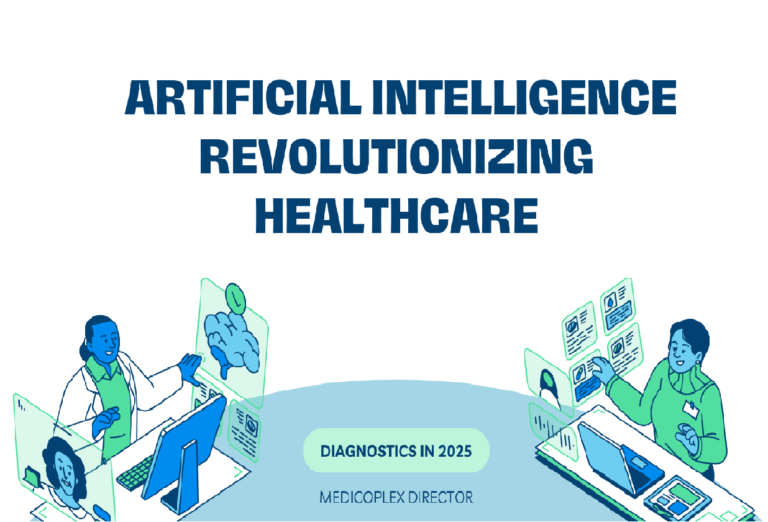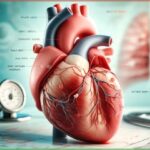AI revolutionizing healthcare is no longer a futuristic concept—it’s a reality shaping medical diagnostics in 2025. With rapid advancements in artificial intelligence, healthcare systems worldwide are experiencing a transformative shift. From early disease detection to personalized treatment recommendations, AI is enhancing the precision, efficiency, and accessibility of diagnostics like never before. In this article, we’ll explore how AI technologies are revolutionizing diagnostic procedures, improving patient outcomes, and reshaping the future of medicine.
The Role of AI in Revolutionizing Healthcare Diagnostics
Artificial Intelligence refers to the ability of machines to mimic human cognitive functions such as learning, reasoning, problem-solving, and decision-making. In healthcare, AI is being used to assist physicians in diagnosing diseases, predicting patient outcomes, and recommending treatments. The increasing availability of big data and advancements in machine learning (a branch of AI) have paved the way for AI to become a game-changer in medical diagnostics.
By 2025, AI’s impact will be felt in nearly every area of healthcare, from primary care to specialized fields like radiology, pathology, and oncology. With its ability to process vast amounts of medical data quickly and accurately, AI is helping to reduce human error, enhance diagnostic accuracy, and improve patient care.
How AI is Transforming Diagnostic Practices
AI is already being used in several areas of diagnostics, and its influence will continue to grow. Let’s look at the key ways AI is transforming diagnostic practices:
Imaging and Radiology
Radiology has been one of the first areas where AI has made a significant impact. AI algorithms can analyze medical images such as X-rays, CT scans, MRIs, and ultrasounds far more quickly than human radiologists and can often detect abnormalities that may be missed by the human eye. Machine learning models, particularly deep learning, can be trained to recognize patterns in medical images, allowing AI to identify conditions like cancer, fractures, and infections early.
For example, AI-driven diagnostic tools like Google Health’s AI for breast cancer detection have demonstrated higher accuracy rates than human radiologists in some cases. By 2025, AI-powered imaging tools are expected to be widely adopted in hospitals, assisting radiologists in diagnosing a wide range of diseases more accurately and efficiently.
Pathology
Pathology, which involves the study of tissue samples, has also seen breakthroughs thanks to AI. Pathologists often need to examine tissue slides under a microscope to detect diseases like cancer. AI can speed up this process by using machine learning algorithms to analyze slides, identify abnormal cells, and even predict the likelihood of certain diseases. This not only improves the speed of diagnosis but also ensures greater consistency and accuracy in detecting conditions such as cancer.
By 2025, AI systems will be able to provide more precise and automated analysis of pathology slides, allowing pathologists to focus more on treatment decisions and patient care rather than time-consuming manual analysis.
Predictive Analytics and Early Detection
One of the most promising applications of AI in diagnostics is its ability to predict diseases before they fully develop. AI can analyze patient data, including medical history, genetic information, lifestyle factors, and lab results, to predict the likelihood of a patient developing a certain condition. This can lead to earlier interventions and preventative treatments, improving patient outcomes.
For example, AI can predict cardiovascular diseases, diabetes, and even certain types of cancers at much earlier stages than traditional diagnostic methods. By 2025, AI systems will be capable of providing real-time predictive analytics for a broader range of diseases, enabling clinicians to initiate preventive measures and personalized treatments much sooner.
Genetic Testing and Precision Medicine
Genetic testing is another area where AI is making a big impact. With the growth of genomics and personalized medicine, AI is being used to analyze vast amounts of genetic data to help diagnose rare diseases and recommend treatments tailored to an individual’s genetic makeup.
AI algorithms can quickly analyze genetic sequences and compare them to vast databases of known genetic disorders, allowing healthcare providers to diagnose rare diseases more efficiently. This is particularly helpful in the field of oncology, where precision medicine based on genetic profiles is becoming more common. By 2025, AI will likely play a central role in the diagnosis and treatment of genetic conditions, contributing to more targeted and effective therapies.
Key Technologies Driving AI in Diagnostics
Several AI technologies are driving innovations in medical diagnostics:
Machine Learning and Deep Learning
Machine learning (ML) and deep learning (DL) are subfields of AI that enable machines to learn from large datasets and improve their performance over time without being explicitly programmed. In diagnostics, ML algorithms are trained on medical data, such as patient records, lab results, and medical images, to identify patterns and make predictions.
Deep learning, which involves the use of neural networks that mimic the human brain’s structure, has shown exceptional promise in areas such as medical image analysis and natural language processing. These technologies enable AI systems to improve diagnostic accuracy by continuously learning from new data.
Natural Language Processing (NLP)
Natural language processing (NLP) allows AI systems to understand and interpret human language. In healthcare, NLP is used to analyze electronic health records (EHRs), patient notes, and medical literature to identify relevant information that can assist in diagnosis. For example, NLP algorithms can extract key symptoms and medical histories from unstructured text in patient records, helping clinicians make more informed decisions.
Computer Vision
Computer vision is another critical AI technology that enables machines to interpret and understand visual data, such as medical images and scans. By combining computer vision with deep learning techniques, AI systems can analyze images with incredible precision, detecting abnormalities and suggesting diagnoses based on visual cues. This technology is already being used in fields like radiology, dermatology, and ophthalmology, and its applications will continue to expand in 2025.
The Benefits of AI in Diagnostics
The integration of AI into healthcare diagnostics offers several advantages:
Increased Accuracy
AI systems have the potential to significantly improve diagnostic accuracy. By analyzing large datasets and detecting patterns that may be missed by human eyes, AI can identify conditions at early stages when treatments are most effective. Studies have shown that AI can outperform human doctors in certain diagnostic tasks, such as detecting breast cancer from mammograms.
Faster Diagnosis
AI’s ability to process large volumes of data quickly means that diagnoses can be made much faster than through traditional methods. This is especially crucial in emergency situations where time-sensitive decisions are needed. Faster diagnosis can also lead to faster treatment, improving overall patient outcomes.
Reduced Healthcare Costs
By increasing the efficiency of diagnostic processes, AI has the potential to reduce healthcare costs. Faster and more accurate diagnoses can help avoid unnecessary tests, reduce the need for repeat visits, and streamline healthcare workflows. In addition, early detection of diseases can lead to cost-effective preventive care, which is often less expensive than treating advanced conditions.
Challenges and Ethical Considerations
Despite the tremendous potential of AI in healthcare diagnostics, several challenges remain:
Data Privacy and Security
The use of AI in healthcare requires access to large amounts of sensitive patient data. Ensuring the privacy and security of this data is critical to maintaining trust in AI-powered systems. Healthcare providers and developers must implement robust security measures to protect patient information and comply with regulations such as HIPAA.
Bias in AI Algorithms
AI algorithms are only as good as the data they are trained on. If the training data is biased or lacks diversity, the AI system may produce inaccurate or biased diagnoses. To ensure fairness and accuracy, AI developers must use diverse and representative datasets and continuously monitor for potential biases in their algorithms.
Regulation and Accountability
As AI becomes more involved in diagnostics, questions around regulation and accountability will need to be addressed. Who is responsible if an AI system makes an incorrect diagnosis? Regulatory bodies will need to establish clear guidelines and frameworks to ensure that AI systems are safe, reliable, and transparent.
What to Expect by 2025
By 2025, AI will likely be an indispensable tool in healthcare diagnostics. We can expect widespread adoption of AI-driven diagnostic tools across various medical specialties, with AI playing an increasingly central role in early disease detection, personalized medicine, and patient care. However, as AI continues to advance, ongoing efforts will be required to address the ethical, regulatory, and technical challenges involved.
FAQ‘s
Q1: How accurate are AI-powered diagnostic tools compared to human doctors?
A: In many areas, AI has demonstrated high accuracy, sometimes surpassing human doctors in specific tasks like interpreting medical images. However, AI is still meant to assist healthcare professionals rather than replace them. Human expertise remains crucial in interpreting results and making final decisions.
Q2: Will AI take over the role of doctors in diagnostics?
A: No, AI is not meant to replace doctors. It is a tool that helps improve diagnostic accuracy, speed, and efficiency. Doctors will still be essential for making final diagnoses, interpreting results, and managing patient care.
Q3: How can AI help in the early detection of diseases?
A: AI algorithms can analyze patient data, medical records, genetic information, and medical images to detect early signs of diseases, such as cancer or heart disease. Early detection allows for timely interventions and better treatment outcomes.
Q4: Is AI safe to use in healthcare?
A: While AI in healthcare is promising, it must be carefully monitored to ensure safety. Healthcare organizations must implement security protocols to protect patient data and ensure that AI systems comply with regulatory standards.
Q5: What are the ethical concerns surrounding AI in healthcare?
A: Ethical concerns include data privacy, algorithmic bias, and accountability. It is important that AI systems are trained on diverse datasets, with strong safeguards in place to protect patient information, and that there are clear guidelines for accountability in the event of an error.
Conclusion
AI continues to transform healthcare, its role in diagnostics will only become more critical. By 2025, AI will not only improve the speed and accuracy of diagnoses but also enable earlier disease detection and personalized treatment options. However, the successful integration of AI in healthcare will depend on overcoming challenges related to data privacy, bias, and regulation. As we move toward 2025, the future of AI in diagnostics looks promising, with the potential to reshape the entire healthcare landscape.


